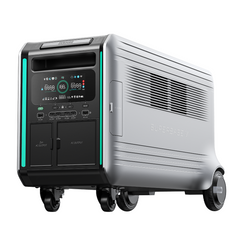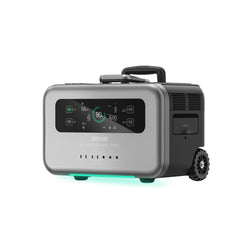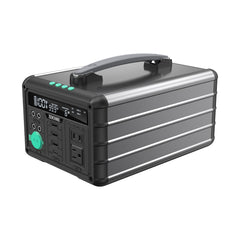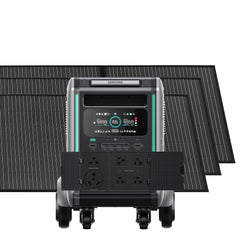400 Watt Solar Panel: All You Need to Know – Costs, Applications and More
A 400 watt solar panel is an attractive option for individuals and businesses looking to contribute to environmental protection while simultaneously reducing their energy costs.
One significant advantage of these solar modules is that, after the initial purchase, they incur no further costs and require minimal maintenance. You can install it on a roof, terrace, or even in a garden to achieve diverse application possibilities. These panels are also often used for off-grid applications like in RVs, boats, and remote cabins. But how big is a 400 watt solar panel? And what can it run? Read on to find out more.
How Sunlight is Converted into Solar Power
The heart of every solar cell is a semiconductor material, mostly silicon. This material is "doped" with foreign atoms to create two differently conductive layers - the negatively charged n-layer and the positively charged p-layer. When sunlight hits the solar cell, electrons are freed from their bonds and pushed towards the n-layer by the resulting electric field. This creates a voltage between the layers, similar to a battery. When the layers are connected through an external circuit, electrons flow from the n-layer to the p-layer, generating usable direct current (DC). The strength of this current depends on the intensity of the incoming light. On a sunny day, a 400W solar module can produce several kilowatt-hours of electricity.
The functioning of solar cells may seem complex, but the principle is remarkably simple: light energy is directly transformed into electrical energy - clean, quiet, and without moving parts. It's no wonder that photovoltaic systems are booming worldwide and making a significant contribution to the energy transition. With every newly installed 400W solar module, the vision of a fully renewable power supply comes a step closer.
How Does a 400 Watt Solar Panel Work?
A 400 Watt solar panel is a photovoltaic module that converts sunlight into electrical energy. The basic principle is the same as with other solar modules: photovoltaic cells made of silicon absorb light energy, which releases electrons that can be used as electric current. With a rated power of 400 watts, it is a relatively compact solar module. This makes it ideal for small solar installations, such as emergency power units or solar generators.
Key features of Zendure 400W Portable Solar Panel include:
- Lightweight and Portable: Weighing in at just 29.98lb (13.6kg), the Zendure 400W solar panel is incredibly lightweight and easy to carry. Whether you're heading out for a weekend camping trip or an extended off-grid adventure, you can take this solar panel with you wherever you go.
- High-Efficiency Solar Technology: With an impressive 22% conversion rate, the Zendure 400W solar panel is designed to extract the most power possible from sunlight. That means you'll get more usable electricity for your devices, even in low-light conditions.
A 400-watt solar module is not just a worthwhile addition to home power supply. It also proves to be a useful companion when camping or hiking when energy for communication devices or cooking utensils away from civilization is needed. Thanks to its modular design, its power output can be increased with additional panels if needed.

Advantages of 400 Watt Solar Panels
High Efficiency and Performance
With a nominal power of 400 watts, these modules can generate significantly more electricity per square meter of solar area than their smaller counterparts. This is made possible by the use of high-efficiency solar cells that achieve efficiency rates of up to 22%. It also means that a larger portion of the incoming sunlight is converted into electrical energy.
Cost-Effectiveness
Thanks to their high efficiency, these panels can produce solar power at lower costs compared to smaller modules. Every euro invested pays off faster through higher yields. Additionally, the acquisition cost per watt-peak for these high-performance modules is often lower than for panels with lower power output.
The contribution that one or more 400-watt panels can make toward independence from the power grid should also not be underestimated. Even a single module can cover a noticeable part of a household's electricity needs.
What Can a 400 Watt Solar Panel Run?
A single 400 watt solar panel can generate between 300 and 450 kilowatt-hours (kWh) of electricity per year, depending on the location and conditions. At first glance, this might not seem like a lot, but it is sufficient to cover a significant portion of the electricity needs for lighting and household appliances. With 300 to 450 kWh, for example, the annual consumption of a modern refrigerator or washing machine can be covered. The lighting of a household with energy-saving LED lamps can also be easily realized with this amount of electricity. Thus, a 400-watt solar module helps reduce dependence on expensive grid electricity and noticeably lowers electricity costs.
To increase the yield and supply even more devices with self-generated solar power, multiple 400 watt panels can, of course, be combined. This way, an even larger portion of a household's electricity needs can be met—from entertainment electronics and kitchen appliances to water heating.
400W solar panels are particularly popular among campers and outdoor enthusiasts. Mounted on a motorhome or tent, they provide a reliable power supply far from civilization. Entertainment electronics, communication devices, and even small kitchen appliances like a kettle or coffee machine can be easily powered by solar energy. For a family of three, a single 400-watt solar panel is often enough to cover the basic electricity needs during a camping holiday or hiking trip.
Ultimately, it becomes clear that even a single 400-watt solar module can make a valuable contribution to the energy transition and climate protection. Every kilowatt-hour generated by solar energy does not have to be obtained from fossil fuels. Thus, every household that relies on solar energy contributes to a cleaner and more sustainable future—while also benefiting from long-term lower electricity costs. It's a win-win situation for all involved.
What Factors Should Be Considered When Buying a 400 Watt Solar Panels?
When purchasing a 400 Watt solar panel, several important factors need to be considered to ensure the best possible performance and profitability:
- Nominal Power: This is a crucial point, as it indicates the maximum electrical power that can be generated under ideal conditions. However, in practice, this will be influenced by various factors, so the actual performance is often lower.
- Sunlight Absorption: It's important that the solar module works efficiently even with low sunlight intensity and has enough space on the roof. Shade from trees, chimneys, or neighboring buildings can significantly impair electricity generation and should be avoided as much as possible.
- Efficiency: Another quality feature is the efficiency, which shows what percentage of the incoming light is actually converted into electrical energy. The values can vary significantly between different modules. An efficiency of at least 20% is recommended, as such modules generate more power per unit area, thereby improving the profitability of the photovoltaic system.
- Warranty and Manufacturer Reputation: The warranty conditions and the reputation of the manufacturer should also be considered in the purchase decision. Reputable providers often offer generous product and performance guarantees of 25 years or more. Certification by independent institutes like TÜV provides additional security.
Considering these factors, you can find the right 400-watt solar module that reliably delivers clean and cost-effective solar power for many years, thus making a valuable contribution to your personal energy transition.
Sizes and Types of Solar Modules
Solar modules come in various sizes and designs depending on the number and size of the built-in solar cells. However, there is currently no unified standard for module sizes as manufacturers use different production facilities.
400-watt solar modules typically measure between 1,720 and 1,762 mm in length and 1,134 mm in width. They are based on the dimensions of modern M10 solar cells and cover an area of just under 2 m². Generally, there is a trend towards larger modules. Today's modules with an area of 1.8 to 2 m² could eventually be replaced by even larger units with 3 m² or more.
Besides size, solar modules can also be classified by the type of solar cells used. Monocrystalline modules are considered particularly efficient as they are made from a single silicon crystal. Polycrystalline modules, on the other hand, consist of multiple crystals and are cheaper to produce but have a slightly lower efficiency. Thin-film modules made from amorphous silicon or other materials like cadmium telluride are flexible and suitable for special applications, but do not quite achieve the performance levels of crystalline modules.
Which module type and size is the best choice in each case depends on individual requirements and spatial conditions. Ultimately, it is about finding the optimal balance between performance, space requirements, and costs.
Lifespan of Solar Modules
Investing in a photovoltaic system naturally comes with the expectation of long-lasting enjoyment and reliable power production. Fortunately, modern solar modules stand out for their impressive durability and comprehensive warranties. Due to weather influences and intense sunlight, the cells "fatigue" over time and convert the incoming light into electricity slightly less efficiently. However, thanks to continuous improvements in cell technology and processing, this effect has been increasingly minimized. Today's modules are significantly more durable and efficient than their predecessors from the early days of photovoltaics.
Weight of Solar Modules
The weight of solar modules is significantly influenced by their size and construction. The differences can be considerable depending on the type and performance. A 400-watt solar module in the classic glass-foil construction typically weighs around 20 kg. On the other hand, if you opt for a glass-glass module of the same power, you can expect a weight of over 25 kg. The reason for the difference lies in the additional glass layer, which protects and stabilizes the module but also makes it heavier.
For even larger modules, such as those often used in ground-mounted solar parks, the weight increases further. PV modules with a power output of 600 watts or more can easily weigh 40 kg or more. This might not seem like much at first glance, but when installing a larger system, the weight can quickly add up to considerable loads.
Compatibility of Solar Modules with Energy Storage Systems
For those who are committed to the energy transition in their own homes, it's crucial to think beyond just operating a photovoltaic system. An intelligent energy storage system forms the perfect complement to solar modules like the 400-watt module as it would unlock entirely new possibilities for energy utilization. The basic idea is simple: excess solar power generated during the day, which is not immediately consumed, is stored in a battery and made available during the evening or nighttime hours. This significantly increases the proportion of self-generated electricity in the household and reduces dependency on the public grid.
Of course, it is essential that the solar modules and the energy storage system used are technically compatible and work together seamlessly. Another fascinating aspect is the integration of thermal management. If the photovoltaic system is adequately sized, the generated electricity can also power a heat pump heating system or an air conditioning unit. In times of rising energy prices and growing environmental awareness, this is an extremely attractive option. However, it is crucial that all components are optimally coordinated and work in sync.
Solar modules, energy storage, electric mobility, and thermal management together form an intelligent integrated system that elevates solar power generation to a new level. Through smart energy management and the use of synergies, consumption and generation can be balanced, dramatically reducing the ecological footprint of the building. Therefore, anyone considering the purchase of a 400-watt solar module or a complete solar system should also consider the possibilities of combining it with storage systems and other components. Only in this way can the full potential of solar energy be realized.
Factors that Influence the Performance of Solar Modules
The performance of a solar module, even a 400-watt solar module, depends on a variety of factors. One of the most important is the current weather. A clear sky allows significantly more sunlight to reach the cells compared to a dense cloud cover. Rain or even snow on the modules also noticeably impair performance.
The location also plays a crucial role. In general, the closer a solar module is to the equator, the higher the global radiation and thus the potentially usable amount of energy. In our latitudes, the angle of inclination of the modules is also important. The optimal yield is achieved when the sun's rays hit the surface at a 90° angle. In Germany, the recommended angle of inclination is therefore between 30 and 40°.
Closely related to this is the orientation of the modules. The best performance is achieved when the panels face directly south. Since most roofs are not perfectly aligned, small compromises often have to be made. Nevertheless, a southward orientation should be aimed for as much as possible to maximize electricity generation from sunlight.
An often underestimated factor is shading. Even small shadows, for example from chimneys, trees, or neighboring buildings, can drastically reduce the performance of a solar module. Although the cells also work in diffuse light, direct sunlight is indispensable for full performance.
Finally, the yield of a solar module depends on its efficiency and size. Modern modules like the 400-watt solar module achieve efficiencies of over 20 percent, converting a significant portion of the incoming light into electricity. The larger the module surface, the more energy can be "harvested".





